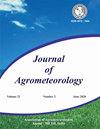Crop-weather relationship of soybean in Marathwada region of Maharashtra
Q3 Agricultural and Biological Sciences
引用次数: 0
Abstract
A long-term experiment was conducted during kharif seasons of2013 to 2020 at AICRP on Agrometeorology, VNMKV, Parbhani, to study the crop-weather relationship of soybean grown under four environments (27th SMW, 28th SMW, 29th SMW and 30th SMW) with three soybean varieties (MAUS-158, MAUS-71, and JS-335). Results indicated that soybean yield was significantly highest in (1541.4 kg ha-1) in the early sown crop, and it decreased with delay in sowing with the lowest yield (803.8 kg ha-1). Among the cultivars, MAUS-158 produced significantly the highest yield (1321.3 kg ha-1). Correlation analysis between weather parameters during different phases with the yield revealed that the vegetative and grain formation period of soybean were found to be the most sensitive to weather parameters, as the correlation coefficients with most of the weather parameters. Rainfall, number of rainy days, humidity and soil moisture had favorable effects while temperatures and sunshine duration had negative effects on the yield of soybean in the Marathwada region. Individual weather parameters during 50% flowering to maturity period could explain 40 to 55% variation in the soybean yield while the multiple regression developed all weather parameters during grain formation to physiological maturity period could explain up to 82% variation which could be used the predict the soybean yield in Marathwada region马哈拉施特拉邦马拉瓦达地区大豆的作物-天气关系
帕尔巴尼的 VNMKV 农业气象 AICRP 在 2013 年至 2020 年喀里多尼亚季节进行了一项长期试验,研究在四种环境(第 27 个法定最低气温日、第 28 个法定最低气温日、第 29 个法定最低气温日和第 30 个法定最低气温日)下种植的大豆与三种大豆品种(MAUS-158、MAUS-71 和 JS-335)的作物-天气关系。结果表明,早播作物的大豆产量明显最高(1541.4 千克/公顷-1),随着播种时间的推迟,产量下降,最低(803.8 千克/公顷-1)。在各栽培品种中,MAUS-158 的产量明显最高(1321.3 千克/公顷-1)。不同阶段的气象参数与产量之间的相关性分析表明,大豆的无性生长期和谷粒形成期对气象参数最为敏感,因为大多数气象参数都与之存在相关系数。降雨量、雨日数、湿度和土壤水分对马拉瓦达地区的大豆产量有有利影响,而温度和日照时间则有不利影响。50%开花至成熟期的单个气象参数可解释 40% 至 55% 的大豆产量变化,而谷粒形成至生理成熟期所有气象参数的多元回归可解释高达 82% 的变化,可用来预测马拉瓦达地区的大豆产量。
本文章由计算机程序翻译,如有差异,请以英文原文为准。
求助全文
约1分钟内获得全文
求助全文
来源期刊

Journal of Agrometeorology
农林科学-农艺学
CiteScore
1.40
自引率
0.00%
发文量
95
审稿时长
>12 weeks
期刊介绍:
The Journal of Agrometeorology (ISSN 0972-1665) , is a quarterly publication of Association of Agrometeorologists appearing in March, June, September and December. Since its beginning in 1999 till 2016, it was a half yearly publication appearing in June and December. In addition to regular issues, Association also brings out the special issues of the journal covering selected papers presented in seminar symposia organized by the Association.
 求助内容:
求助内容: 应助结果提醒方式:
应助结果提醒方式:


